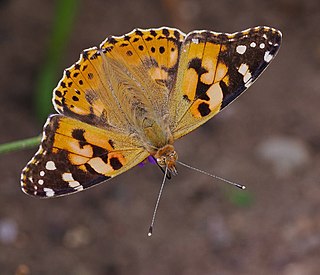
Cynthia is a group of colourful butterfly species that used to be considered a subgenus of the genus Vanessa, in the family Nymphalidae. Before that, it was first described as a genus. Nowadays, this group is not considered a valid taxon anymore, because it is paraphyletic. The name CynthiaFabricius, 1807 is now a junior subjective synonym of VanessaFabricius, 1807.

The Pieridae are a large family of butterflies with about 76 genera containing about 1,100 species, mostly from tropical Africa and tropical Asia with some varieties in the more northern regions of North America and Eurasia. Most pierid butterflies are white, yellow, or orange in coloration, often with black spots. The pigments that give the distinct coloring to these butterflies are derived from waste products in the body and are a characteristic of this family. The family was created by William John Swainson in 1820.

The Luna moth also known as the American moon moth is a Nearctic moth in the family Saturniidae, subfamily Saturniinae, a group commonly known as giant silk moths. It has lime-green colored wings and a white body. The larvae (caterpillars) are also green. Typically, it has a wingspan of roughly 114 mm (4.5 in), but can exceed 178 mm (7.0 in), making it one of the larger moths in North America. Across Canada, it has one generation per year, with the winged adults appearing in late May or early June, whereas farther south it will have two or even three generations per year, the first appearance as early as March in southern parts of the United States.

The meadow brown is a butterfly found in the Palearctic realm. Its range includes Europe south of 62°N, Russia eastwards to the Urals, Asia Minor, Iraq, Iran, North Africa and the Canary Islands. The larvae feed on grasses.
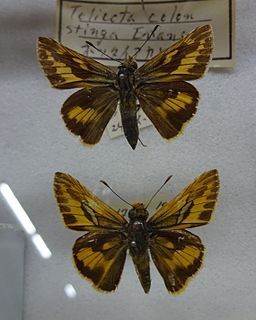
Telicota colon, commonly known as the pale palm dart or common palm dart, is a butterfly belonging to the family Hesperiidae found in India to Australia.

Automeris io, the Io moth or peacock moth, is a colorful North American moth in the family Saturniidae. The io moth is also a member of the subfamily Hemileucinae. The name Io comes from Greek mythology in which Io was a mortal lover of Zeus. The Io moth ranges from the southeast corner of Manitoba and in the southern extremes of Ontario, Quebec, New Brunswick and Nova Scotia in Canada, and in the US it is found from Montana, North Dakota, South Dakota, Nebraska, Colorado, New Mexico, Texas, Utah, east of those states and down to the southern end of Florida. The species was first described by Johan Christian Fabricius in 1775.

Daphnis nerii, the oleander hawk-moth or army green moth, is a moth of the family Sphingidae. It was described by Carl Linnaeus in his 1758 10th edition of Systema Naturae.

Smerinthus ocellatus, the eyed hawk-moth, is a European moth of the family Sphingidae. The species was first described by Carl Linnaeus in his 1758 10th edition of Systema Naturae.
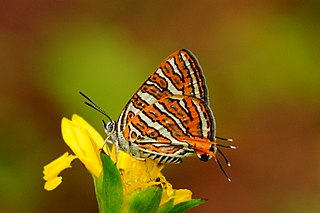
Cigaritis vulcanus, the common silverline, is a species of lycaenid or blue butterfly found in Asia. It was first described by Johan Christian Fabricius in 1775.

Actias isis is a moth of the family Saturniidae first described by Léon Sonthonnax in 1899.

Discophlebia catocalina, the yellow-tailed stub moth is an Australian moth species found in the south-eastern quartile of Australia. It is classified within the Oenosandridae moth family in the Noctuoidea Superfamily, the largest superfamily of the Order Lepidoptera. It is visually recognised by its characteristic pointed yellow tail and is a medium-sized moth species with a wingspan range of 40mm-60mm depending on gender. Discophlebia Catocalina have evolved to feed on various species of eucalypt.

The sheep moth, or common sheep moth, is a member of the family Saturniidae of silk moths and is native to western North America. In California, its range is west of the Sierran crest and the mountains of Southern California, ranging near to the coast. The moth is dayflying and appears in summer. It feeds on plants of three genera: Ceanothus, Rhamnus, and Rosa. Nuttall's sheep moth and one other species are similar, occurring in sagebrush areas east of the Sierra Nevada. The species was first described by Jean Baptiste Boisduval in 1852.
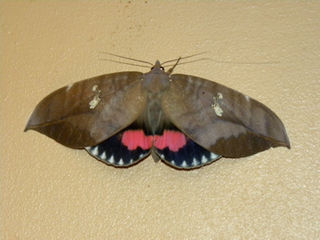
Phyllodes imperialis, the imperial fruit-sucking moth or pink underwing moth, is a noctuoid moth in the family Erebidae, subfamily Calpinae. It was first described by Herbert Druce in 1888. The species can be found in north-eastern Queensland to northern New South Wales, Papua New Guinea, Solomons, Vanuatu and New Caledonia.

Catocala delilah, the Delilah underwing, is a moth in the family Erebidae. The species was first described by Strecker in 1874. It is found in the southern and midwestern United States, from Ohio south to Florida and west to Texas and Oklahoma.

Erebia melampus, the lesser mountain ringlet, is a member of the subfamily Satyrinae of the family Nymphalidae.
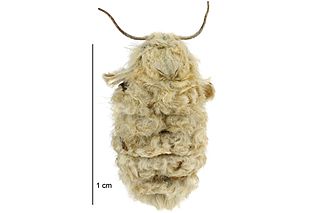
Metacrias erichrysa is a species of moth of the family Erebidae. It is endemic to New Zealand. This species can be found in the lower half of the North Island and western alpine areas of the South Island. The adult female of the species is flightless and buff coloured whereas the male is brightly coloured and a rapid flier during daylight hours. The male of the species is on the wing from mid-November to early January. The species inhabits open herb and tussock fields in mountainous terrain at altitudes of between 900 and 1200 m. Larvae feed on Brachyglottis bellidioides,Festuca novae-zealandiae and indigenous species from the genera Acaena, Muehlenbeckia, Wahlenbergia and Raoulia.
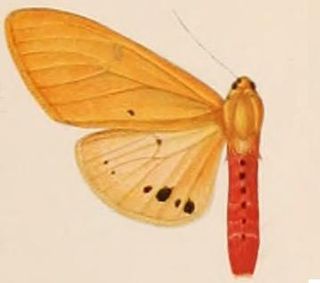
Spilosoma eldorado is a moth of the family Erebidae. It was described by Walter Rothschild in 1910. It is found in eastern India and Sri Lanka.

Euphaedra eleus, the Eleus orange forester, is a butterfly in the family Nymphalidae. It is found in Guinea, Sierra Leone, Liberia, Ivory Coast, Ghana, Nigeria, Cameroon, Gabon, the Republic of the Congo, Angola, the Democratic Republic of the Congo and Uganda. The habitat consists of primary forests and secondary forests with a closed canopy.
Xenomigia caesura is a moth of the family Notodontidae. It is found in north-eastern Ecuador.

Hemileuca lucina, the New England buck moth, is a species of moth in the family Saturniidae. This moth species is only found in the New England region of the United States. Larvae in early stages mainly feed on meadow-sweet whereas larvae in later stages show variation in food sources such as blackberry and black cherry leaves. Larvae have a black body with orange/black spines on their back that are used to deter predators. Pupation occurs during the summer and adult moths come out around September.



















